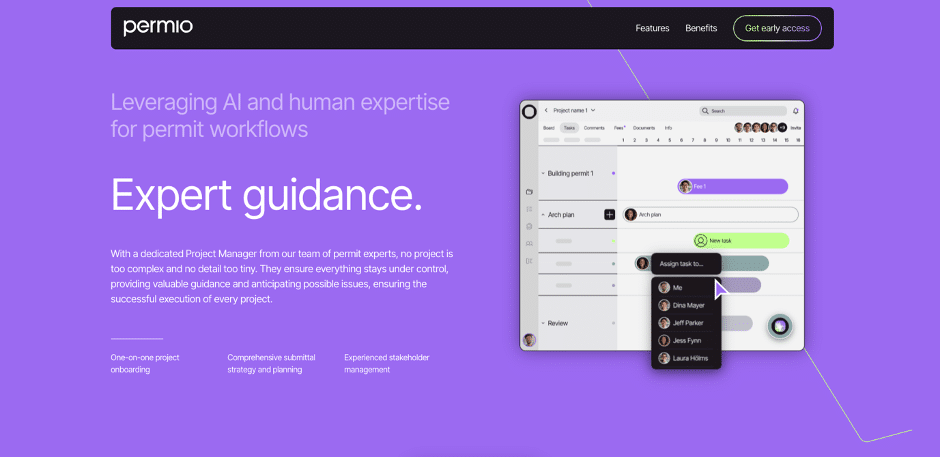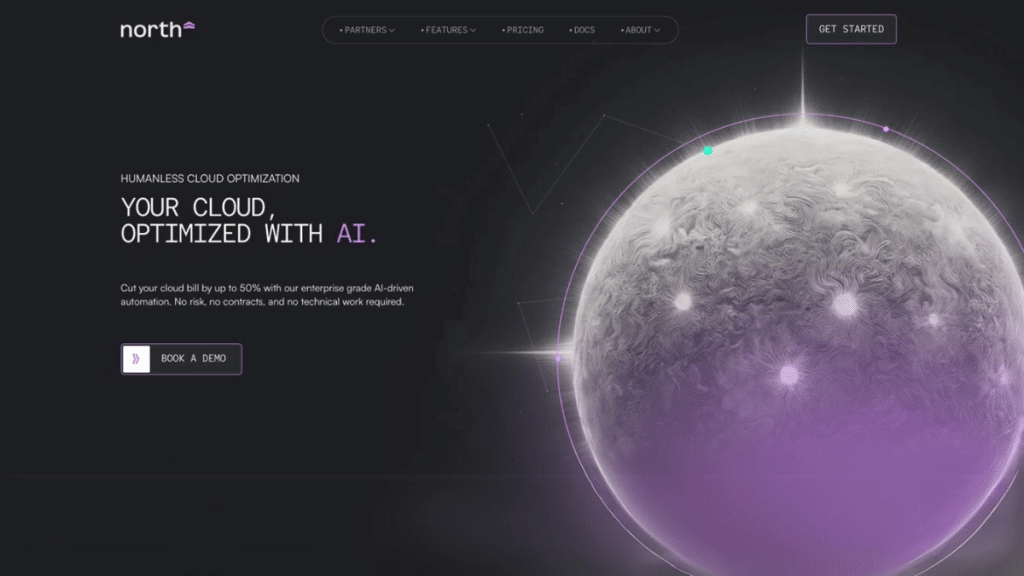Make sure your website drives the results you are expecting: Whether you’re building just a landing page or you’re planning to launch a full startup website, several key factors should be prioritized to ensure that it is both user-friendly and effective for business growth. Follow this guide to attract prospects, engage your audience, and collect leads.
Communicate your value proposition: Short, clear, and meaningful
Your website must immediately communicate what your startup offers and why it matters. A concise, compelling headline and subheading in the above-the-fold section of your homepage should clearly explain the value of your product or service. This is not the place to get stuck in lengthy copy or exhaustive descriptions. Take your time to reshape the wording until it sums up your major benefit for your target audience briefly and in an understandable way.
Have a look at how the Cloud startup North nailed its value proposition to fit into a short yet effective above-the-fold copy.
Ensure brand consistency: Your branding matters
Your visual identity or, more broadly speaking, your branding is crucial for your startup website. Throughout the web design, it is the point of reference that will influence layouts and sections.
A strong brand identity differentiates your startup from competitors and builds trust and credibility with your target audience. Consistent branding across your website—through elements like logo, color schemes, typography, and branded illustrations and animations—creates a cohesive experience that resonates with visitors and reinforces your company’s values. It also helps foster emotional connections with customers, making them more likely to engage and return.

For startups, branding is not just about aesthetics; it’s about establishing a unique presence and fostering long-term loyalty from the start. To set the direction for your visual identity, strategy is one of the most important elements. Top startup branding agencies like The Branx keep in mind your mission, vision, market positioning, and value proposition to create a visual identity that makes you stand out from the competition and enhance your online presence. They work with B2B and B2C businesses, applying a strategic approach to each of their branding projects for startups.
Establish trust: Testimonials, partner logos, security badges
Incorporate elements that build credibility and trust, such as customer testimonials, certifications, security badges (for e-commerce), and clear contact information. These signals reassure visitors that your startup is reliable and trustworthy.
If you are in a very early stage of your business, you might not yet have reviews or partners you can count on. Alternatively, you can include investors or the industry experience of your founders.
Simplify navigation: User-friendly and intuitive
Your website’s layout should be simple and intuitive, enabling users to explore your web without getting lost. Visitors should be able to find key information easily and well-organized navigation helps keep users engaged and increases the likelihood of conversion.
If you create a landing page with a lot of content, make sure to include anchor links that lead the user to the corresponding sections.
For a website with various pages and sub-pages like Services, Product, Features, Pricing, Company, etc., one of the most used tactics is to create a super navbar with brief introductions to each section. According to statistics, users spend an average of 6.44 seconds focused on the main navigation menu, reflecting the importance of having a clear navbar (Source: Forbes). Check out BlueCloud’s super navbar with icons next to each page, structuring the overview and leading the eye toward the information.

Ensure mobile responsiveness: Layouts, animations, interactions
54% of web traffic comes from mobile devices (Source: Forbes). Although this number varies depending on the industry your startup is in, ensuring that your website is fully responsive across all screen sizes is critical. A mobile-friendly design improves user experience and can positively impact your site’s search engine rankings.
To create a mobile-friendly website or landing page for your startup, make sure all your layouts and animations fit seamlessly into phone screens and interactions function smoothly and seamlessly also on mobile devices.
For each device, make sure page performance including loading speed is high. Slow websites can lead to higher bounce rates, causing visitors to leave before engaging with your content, which negatively impacts user experience and search engine rankings. 47% of users won’t wait longer than two seconds for a website to load (Source: Forbes). A fast-loading site not only improves user satisfaction but also boosts your SEO, as search engines like Google prioritize websites that offer quicker load times and smooth performance. Use tools like PageSpeed Insights from Google to check your web’s performance.
Optimize for search engines: On-page and off-page SEO
Although AI search engines are gaining popularity, the key principles for a successful web remain the same. By optimizing on-page and off-page SEO continuously, you ensure your web gains visibility, helping search engines understand the context of your site and improving its chances of ranking for relevant searches.
On-page SEO involves optimizing individual pages through relevant keywords, meta tags, headers, and quality content. By focusing on elements like content structure, internal linking, and keyword usage, you ensure your startup website or landing page is both user- and search-engine-friendly.
Off-page SEO focuses on improving the authority and trustworthiness of your site by building quality backlinks and establishing a strong online presence beyond your website. This involves getting other reputable websites to link back to yours, which search engines see as a signal that your content is valuable and reliable.
By focusing on these aspects, you can create a website that not only attracts visitors but also drives meaningful engagement and growth for your startup. The visuals used in this article are drawn from startup branding and web projects by The Branx.
